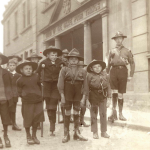Passage from India
During her early years, Alice Mary Lillie’s life of colonial privilege was tempered with tragedy. Described as a “very clever woman” by Charles M Tuke when admitted to Chiswick House in November 1914, Alice was born in November 1867 to James Conder and Mary Ann Ayres in Wood Green, now North London, then classed as Middlesex.
She spent her early childhood in India after her father became a railway engineer helping to build the Empire’s infrastructure. Even on a modest engineer’s salary, Alice and her brothers Samuel and Charles would have lived in relative luxury in this new, exotic environment with servants and ayahs indulging their every desire. Three siblings were born after the family’s arrival in India but all died in infancy.
Alice and her brothers Samuel and Charles would have lived in relative luxury in (India) with servants and ayahs indulging their every desire.
On 14 May 1873, Alice’s mother died of tuberculosis in Bombay (now Mumbai). Soon after, Alice’s brothers were sent home to boarding school in England in the care of one of their mother’s friends, Mrs Elizabeth Pryce – more than likely the same ‘Mrs Price (sic)’ who was to visit Alice in 1915 at Chiswick House. James Conder married again in March 1876 and started a new family in India with his 17-year-old second wife Mary Harriet Thomas.
Death in Kent and a doomed artist
Alice may have remained in India with her father for some time but by 1881 she was studying and living with Mr and Mrs Pryce and her brothers in Gravesend, Kent. She was baptised in a local church in 1882.
Alice endured another family loss when her elder brother Samuel died of TB in 1883, aged just 17. Their brother, Charles, was said to have been distraught at Samuel’s death. Their father, apparently an austere and religious man, decided that the sensitive and artistically inclined Charles needed to be put to work in the service of the Empire. In 1884 Charles was dispatched to Sydney, Australia to work as a land surveyor for his uncle.
Not his chosen career, Charles Edward Conder gradually found his own path and became one of the leading artists in the Australian Impressionism (or Heidelberg) movement. He was a handsome and charming bohemian, who enjoyed a party lifestyle. Eventually this manifested itself in a case of syphilis, leading to the “general paresis of the insane,” of which Charles died in 1909 in a Surrey sanatorium, aged just 40 years. He had allegedly caught the disease from an Australian landlady whom he was paying in kind! Today Charles remains a highly regarded artist across the world.
To Folkestone via Rajasthan
At some point Alice returned to India, becoming a colonial wife on Christmas Eve 1895 when she married George Ernest Lillie in Ajmer, Rajasthan. Their three children (Cecil, William and Hazel) were all born in India around the turn of the century. We don’t know how much contact Alice’s father James had with his first family, but he died in England in 1910.
In June 1911, Alice and her two younger children arrived in Liverpool after sailing from Bombay. Perhaps the older boy was already at school in England? Soon after, all three children and their mother were living in Folkestone, a fashionable Edwardian coastal resort. George seems to have continued working overseas throughout his wife’s stay at Chiswick House, writing to her and trying to visit when he could get back to England. I wonder if she ever welcomed him?
Alice’s final days
When Alice died in Norfolk in the early 1930s, George had retired and was a town councillor living in Folkestone’s leafy Kingsnorth Gardens. He went on to live until 1960 when he was 89, having by then moved to Cheltenham, Gloucestershire. The couple’s children all outlived their parents. Both boys followed in their father and grandfather’s footsteps to India, serving in the armed forces. Neither had their own families, but Hazel married twice and had her own daughter.
From an early age Alice suffered a number of highly stressful events: moving to colonial India from the London suburbs; losing her mother and both brothers within a few years; her father starting a whole new family; and raising her own family while her husband worked overseas. It is not difficult to find incidents in her life that could have acted as triggers for Alice’s eventual mental breakdown, a condition I believe may have been some form of schizophrenia.
It is not difficult to find incidents in her life that could have acted as triggers for Alice’s eventual mental breakdown, a condition I believe may have been some form of schizophrenia.
If Alice were diagnosed with similar symptoms today, it is likely she would be treated with anti-psychotic medication and cognitive behavioural therapy (CBT), which have been shown to have some success in reducing the effects of schizophrenia. Although there can be relapses, many people suffering from schizophrenia are now able to lead a more active day-to-day life, living in their own homes and with much less distress for themselves, friends and family than in Alice’s day.
Sadly, though her treatment seems to have been humane and well meaning, it is unlikely to have had any lasting therapeutic effect on whatever condition she was suffering from. However, she was lucky in one sense; her family were relatively affluent, and seem to have taken an interest in her wellbeing. Many other people in Alice’s position at this time would not have had the means to take advantage of the treatment, however ineffective, that was offered at Chiswick House, and other progressive private asylums.










